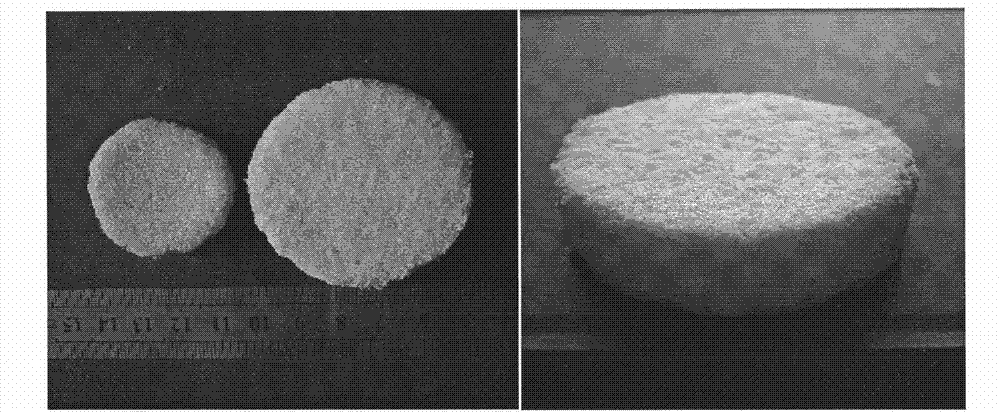Method for preparing three-dimensional silk fibroin porous scaffold material
A technology of porous scaffolds and three-dimensional silk fibroin, applied in medical science, prosthesis, etc., can solve the problems of tediousness, toxicity of scaffolds, inability to effectively prepare porous silk fibroin scaffolds, etc., and achieve the effect of reducing costs and simplifying process conditions
- Summary
- Abstract
- Description
- Claims
- Application Information
AI Technical Summary
Problems solved by technology
Method used
Image
Examples
Embodiment 1
[0028] The sodium chloride is passed through a 200 mesh sieve. Heat 20 ml of a silk fibroin solution with a concentration of 2 wt% to 60°C, and add 20 g of sodium chloride while stirring gently. After the silk fibroin solution gels, let it stand still to make the silk fibroin gel settle completely, remove the upper clear liquid, and leave the precipitated part. Continue to stir to mix the precipitate evenly, then put the precipitate into the mold and dry. The dried sample is immersed in distilled water together with the container until the sodium chloride in the stent is completely dissolved, and finally a three-dimensional silk fibroin porous stent material is obtained with a porosity of 98.1%.
Embodiment 2
[0030] Repeat the method of Example 1, wherein the volume of the silk fibroin solution is 40 ml and the mass of sodium chloride is 20 g, and the finally obtained three-dimensional silk fibroin porous scaffold material has a porosity of 99.3%.
Embodiment 3
[0032] The method of Example 1 is repeated, wherein the concentration of the silk fibroin solution is 50 wt%, the volume is 100 ml, and the mass of sodium chloride is 10 g, and the finally obtained three-dimensional silk fibroin porous scaffold material has a porosity of 69.4%.
PUM
| Property | Measurement | Unit |
|---|---|---|
| porosity | aaaaa | aaaaa |
| porosity | aaaaa | aaaaa |
| porosity | aaaaa | aaaaa |
Abstract
Description
Claims
Application Information
 Login to View More
Login to View More - R&D
- Intellectual Property
- Life Sciences
- Materials
- Tech Scout
- Unparalleled Data Quality
- Higher Quality Content
- 60% Fewer Hallucinations
Browse by: Latest US Patents, China's latest patents, Technical Efficacy Thesaurus, Application Domain, Technology Topic, Popular Technical Reports.
© 2025 PatSnap. All rights reserved.Legal|Privacy policy|Modern Slavery Act Transparency Statement|Sitemap|About US| Contact US: help@patsnap.com



